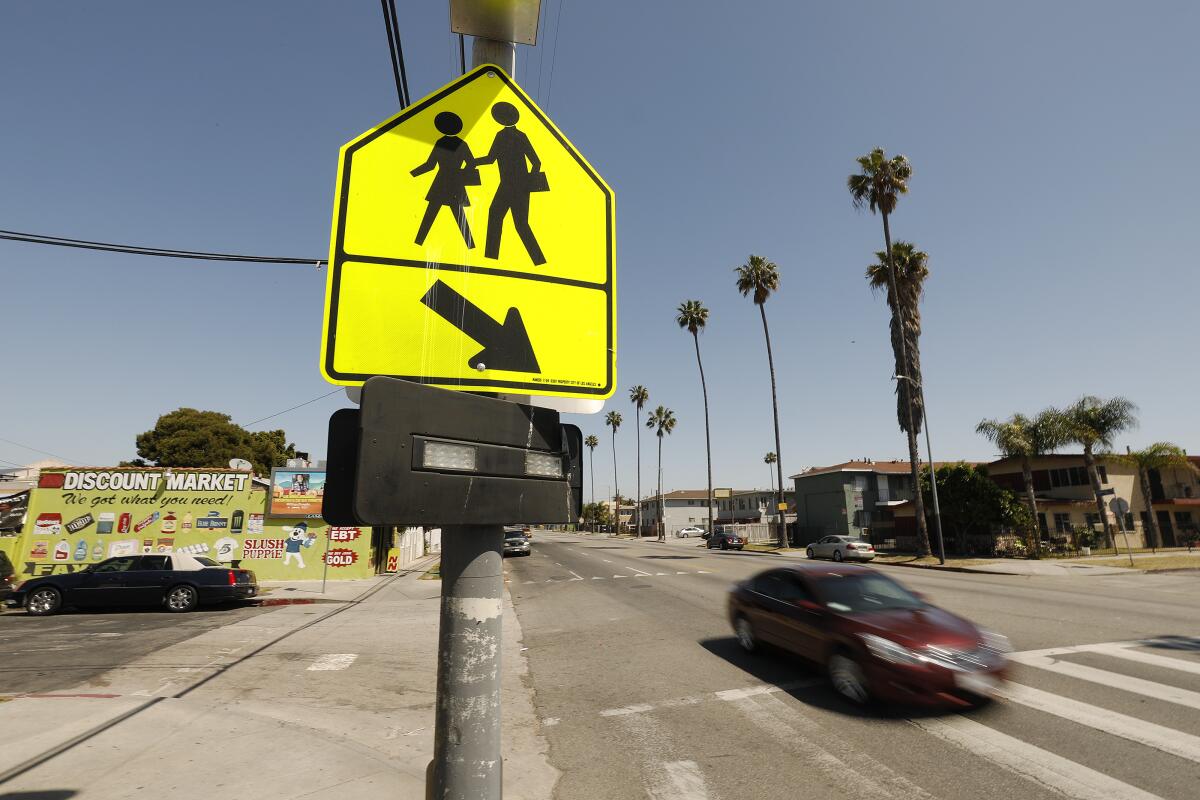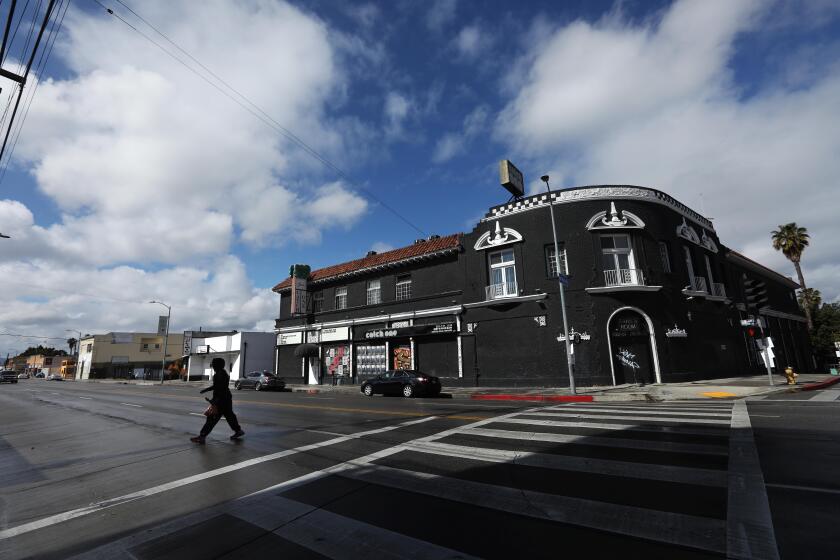L.A. invented jaywalking tickets to serve cars. It’s time to give streets back to walkers

- Share via
California’s new Freedom to Walk Act does not exactly decriminalize jaywalking. It leaves plenty of room for police discretion to ticket unsafe walking, and it doesn’t challenge cars’ domination of city streets. Yet the new law is still a remarkable acknowledgment that we need a future in which walking is accommodated, not deterred, and convenient, not constrained.
Like the removal of an old monument or the renaming of a building, the law signals new possibilities. It follows similar initiatives elsewhere, notably in Virginia, where jaywalking ceased to be a primary offense in 2021.
Walking in America is dangerous, and the risks have been growing. In 2021 more than 7,000 pedestrians were killed on the nation’s streets and roads. In 2007 pedestrians accounted for 11% of all traffic deaths; in 2021 their share was 17%. The risks fall disproportionately on low-income people and people of color.
The grim status quo is the legacy of a revolution we have mostly forgotten. A century ago, as automobiles proliferated on city streets, the numbers of pedestrians killed rose steeply. In cities, most of the people killed in traffic were pedestrians, many of them children. By the conventional wisdom of that era, the fault was obvious. Pedestrians were entitled to the safe and convenient use of city streets, so almost everyone blamed fast drivers. Speed was the lethal factor, so speed — not walking — had to be curtailed.
If people sometimes jaywalk to reach their destination, that’s a design flaw rather than a human flaw. California should stop ticketing jaywalking.
Street design techniques that slow drivers down were common. Today we would call them “traffic calming,” but in 1922 they were just routine municipal engineering. Yet the death toll still rose. In the newspapers, editorial cartoonists compared drivers to the Grim Reaper; letters to the editor pleaded for safer conditions for pedestrians. Many demanded laws that would require cars to be equipped with mechanical speed governors that would prevent drivers from exceeding 25 mph.
Such demands alarmed the people with a business interests in motor vehicles. Responding to this threat in an industry publication, they called for “a radical revision of our conception of what a city street is for.” Their effort to protect their market for automobiles left us a legacy of highly restricted walking and the notion that streets are primarily for cars.
In the 1920s, auto clubs worked hard to deter walking that slowed drivers down. A favorite technique was ridicule. By the era’s slang, a “jay” was a rube, so a “jay walker” was a foolish person who did not know how to walk in a 20th century city.
The automobile industry’s trade association also promoted the marginalization of walking. In 1924, it introduced a news service that sent stories to newspapers blaming pedestrians for their own injuries and deaths.
Los Angeles, the most motorized city in the world, led the trend. In 1923, the Automobile Club of Southern California persuaded L.A. police to issue an order limiting pedestrians to sidewalks and street crossings. The club posted 60 signs along Broadway, from 1st Street and extending eight blocks south. The signs displayed the club’s logo and warned pedestrians: “Jay Walking Prohibited by Order Police Department.”
Wanting something more permanent, a young Los Angeles Studebaker dealer, Paul G. Hoffman, was the driving force in developing a new traffic ordinance to codify the police order. Hoffman was the nation’s most successful Studebaker salesman; decades later, he recalled that in 1924, “traffic jams and a high accident rate had begun to create sales resistance.” He wanted to restrict pedestrians so that motorists could drive unimpeded.
Californians will have greater freedom to jaywalk without the threat of a ticket.
With backing from Hoffman, the auto club and other L.A. interest groups, the city adopted the traffic ordinance, including provisions that restricted walkers and gave motorists priority on the streets. It took effect after midnight on Jan. 24, 1925. The first arrest — with a $5 fine — came at 2 o’clock that morning.
The proponents of this “radical revision” of the street were impressed. Automotive interest groups united behind the L.A. ordinance, promoting it to other California cities. In 1928, a version of it was adopted by a U.S. Commerce Department committee, chaired by a Cadillac salesman. As the “Model Municipal Traffic Ordinance,” it was recommended to cities nationwide. Through this lineage, the 1925 traffic law, written at the request of a Studebaker salesman, is the ancestor of restrictive state and local pedestrian regulations across the country.
Defenders of pedestrian restrictions insist that the rules are necessary to protect pedestrians. The laws’ history, however, indicates the actual purpose: to permit fast driving nearly everywhere, even in cities.
In cities, giving primacy to cars has worked to the detriment of lower-income pedestrians and favored suburbanites over local residents. Those results are made worse by disparities in enforcement of traffic laws against people of color. Police disproportionately stopping Black drivers — the notorious “driving while Black” effect — has long had a less widely recognized relative: racial profiling of pedestrians for walking while Black.
Prioritizing cars nearly everywhere has deterred walking, even where it would be a practical mode of everyday mobility. Numerous examples illustrate that in cities where walking is welcome and convenient, it is common — and where walking is common, it is safer.
Nearly a century after the Los Angeles traffic ordinance set a model for the nation, we need a second radical revision in our conception of city streets. We need a future of safer and more sustainable cities, with mobility that is more inclusive, equitable and healthful. California’s Freedom to Walk Act is a welcome step in this new direction.
Peter Norton is associate professor of history in the University of Virginia’s Department of Engineering and Society. He is the author of “Fighting Traffic: The Dawn of the Motor Age in the American City” and of “Autonorama: The Illusory Promise of High-Tech Driving.”
More to Read
A cure for the common opinion
Get thought-provoking perspectives with our weekly newsletter.
You may occasionally receive promotional content from the Los Angeles Times.











